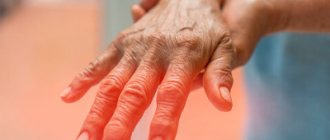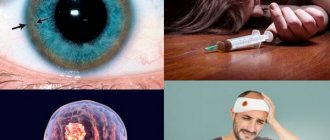What is Restless Legs Syndrome?
Restless legs syndrome is a pathological condition consisting of an obsessive desire to move the legs, caused by a number of certain unpleasant sensations in the lower extremities. These sensations with restless legs syndrome can be pain or aching in the muscles, as well as itching, a burning sensation, crawling distension or twitching in the lower extremities.
Restless legs syndrome
These subjective symptoms more often occur at night or when taking a horizontal body position and relaxing. A significant weakening of the above symptoms occurs with contraction of the muscles of the lower extremities. Therefore, patients with restless legs syndrome have an obsessive need to move the lower extremities.
Causes
In most cases, RLS occurs in the absence of any other neurological or physical disease. RLS can be primary (ideopathic) or secondary (associated with various pathological conditions).
Medical conditions that may cause secondary RLS.
- Pregnancy
- Peripheral neuropathy
- Iron deficiency
- Radiculopathy
- Kidney failure
- Parkinson's disease
- Spinal cord injuries
- Diabetes
- Postgastrectomy syndrome
- Rheumatoid arthritis
- Abuse of strong drinks, coffee, tea and smoking.
It should be noted that not all patients with these conditions experience RLS. Sometimes there are familial cases when the disease is observed in several generations.
Treatment for restless legs syndrome
Taking multivitamins, anticonvulsants, and giving up bad habits often help get rid of restless leg syndrome.
Restless legs syndrome is a fairly common complaint in patients suffering from varicose veins for a long time. Chronic venous insufficiency, which occurs with varicose veins, disrupts the electrolyte balance in the tissues of the lower extremities, leading to the appearance of restless legs syndrome. This condition is well known to many patients with varicose veins. In some cases, wearing compression stockings may help, providing some relief. However, after some time, restless legs syndrome returns. Only radical treatment of varicose veins helps patients completely get rid of restless legs syndrome.
Restless legs syndrome is not a symptom exclusively of varicose veins. There are many other causes of restless legs syndrome. It is very likely that a therapist or neurologist will be able to help. However, if you have restless legs syndrome, it is better to visit a phlebologist and undergo a diagnosis of the venous system of the lower extremities.
Diagnosis of restless legs syndrome
If you have varicose veins, lifestyle changes and vitamin supplements will not be able to completely rid you of restless legs syndrome. Only good treatment for varicose veins will be an effective remedy for restless legs syndrome in this situation.
Hope for the future
Although there is no targeted treatment for this condition, researchers are working to learn more about RLS.
“Even though scientists have discovered these facts, treating RLS remains challenging. Since iron deficiency occurs in the brain, it is not easy to get it there. We are looking at iron treatments, trying oral and intravenous iron. Sometimes treatment doesn't work. There is an assumption that iron deficiency can change genetics or other processes in the body, so even after replenishing the deficiency, the patient's condition remains the same. We are working on new iron therapy treatments for people who do not respond to standard therapy. In addition, other treatments for RLS are being explored.”
Patient Questions About Restless Legs Syndrome
My legs twitch when falling asleep, what should I do?
If your legs twitch when falling asleep, you need to figure out the cause of this phenomenon. Convulsive contractions of the muscles of the lower extremities can be caused by a number of reasons. First you need to visit the following specialists: a neurologist and phlebologist. An ultrasound duplex examination of the veins of the lower extremities must be performed. Having understood the cause of the condition, it will be possible to completely get rid of convulsive twitching at night.
How to treat restless legs syndrome?
To understand how to treat restless legs syndrome, it is necessary to find out the cause of its occurrence. This will require consultations with the following specialists: a neurologist, phlebologist and therapist.
My legs twist a lot at night, what should I do?
If you experience severe leg cramps at night, seek medical attention. A very common cause of this condition is chronic venous insufficiency, complicating varicose veins.
Pain in legs at night when lying down, which doctor should I go to?
If you have pain in your legs at night when lying down, the first doctor you should visit is a phlebologist. At the beginning, it is necessary to exclude venous pathology. Perhaps a phlebologist will completely solve your problem.
How to treat RLS: doctors' recommendations
After confirming the diagnosis, doctors advise:
- moderate physical activity during the day;
- quitting smoking, drinking alcohol, and caffeinated drinks;
- hot foot baths, rubbing feet before bed;
- physiotherapeutic procedures (massage, mud wraps, electromagnetic stimulation, etc.).
As for drug therapy, how to treat a person is always determined on an individual basis. If serum iron levels decrease, replacement medications are prescribed (in combination with vitamin C to increase bioavailability). In the vast majority of cases, this is enough to improve the condition. If the desired effect is absent, the problem of how to relieve spasms and other symptoms of the disease can be solved with the help of anticonvulsants and antiparkinsonian drugs.
Sometimes patients complain that they do not know how to sleep and how to calm down; the approaching night already causes them a distinct fear of another attack of pain and cramps. , benzodiazepine tranquilizers will help cope with psychosomatics and emotional disorders
You can get more detailed information on the treatment of the syndrome in honey from our consultants by phone 8(969)060-93-93.
O.S. Levin Department of Neurology, Russian Medical Academy of Postgraduate Education, Center for Extrapyramidal Diseases, Moscow
Key words: restless legs syndrome, madopar.
Restless legs syndrome (RLS) is a sensorimotor disorder characterized by unpleasant sensations in the lower extremities that appear at rest (usually in the evening and at night), force the patient to make movements that relieve them and often lead to sleep disturbances [1, 4, 8]. RLS was first described by Thomas Willis in 1672, but systematic study of the syndrome began only in the 40s of the 20th century with the work of the Swedish neurologist KA Ekbom, after whom RLS was named Ekbom syndrome [7]. In more than half of cases, RLS occurs in the absence of any other neurological or physical disease (primary or idiopathic RLS). Primary RLS typically appears in the first three decades of life (early-onset RLS) and may be hereditary. In various clinical series of RLS, the proportion of familial cases ranged from 30 to 92%. Analysis of family cases indicates a possible autosomal dominant type of transmission with almost complete penetrance, but variable expressivity of the pathological gene. Both polygenic and monogenic nature of the disease are assumed. In some families, an association of RLS with loci on chromosomes 12, 14 and 9 has been identified. It is possible that in a significant proportion of cases the disease is multifactorial in nature, arising as a result of a complex interaction of genetic and external factors [3, 5, 8]. Symptomatic (secondary) RLS often debuts after 45 years of age (late-onset RLS) [2, 5]. The three main causes of secondary RLS are pregnancy, uremia, and iron deficiency (with or without anemia). RLS is detected in 15-80% of patients with uremia (most often in people on dialysis) and in almost 20% of pregnant women. In pregnant women, symptoms appear only in the II-III trimester and disappear within a month after delivery, but sometimes persist. In addition, cases of RLS have been described in diabetes mellitus, amyloidosis, cryoglobulinemia, vitamin B12 deficiency, folic acid deficiency, thiamine deficiency, magnesium deficiency, alcoholism, thyroid disease, rheumatoid arthritis, Sjögren's syndrome, porphyria, occlusive arterial disease, or chronic venous insufficiency of the lower extremities. RLS has also been described in patients with radiculopathies, as well as with lesions of the spinal cord, usually in the cervical or thoracic regions (for example, with trauma, spondylogenic cervical myelopathy, tumors, myelitis, multiple sclerosis). It is possible that in some patients with RLS, iron deficiency, coffee abuse, polyneuropathy or other factors only reveal an existing hereditary predisposition, which partly blurs the boundary between the primary and secondary variants of RLS [2]. RLS is sometimes detected in patients with Parkinson's disease, essential tremor, Tourette's syndrome, Huntington's disease, amyotrophic lateral sclerosis, post-polio syndrome, but it remains unclear whether this combination is due to chance (due to the high prevalence of RLS), the presence of common pathogenetic mechanisms, or the use of medicines [2, 13]. General and neurological examination of patients with primary RLS usually does not reveal any abnormalities. But with symptomatic RLS, signs of a somatic or neurological disease, primarily polyneuropathy, can be detected. In primary RLS, symptoms usually persist throughout life, but their intensity can fluctuate significantly - it is temporarily intensified during periods of stress, due to the consumption of caffeine-containing products, after intense physical activity, and during pregnancy. In most cases, there is a tendency for symptoms to slowly worsen over time. But sometimes there are periods of stationary course or remission, which can last from several days to several years. Long-term remissions are observed in 15% of patients. In secondary RLS, the course depends on the underlying disease, but there is often a tendency for symptoms to rapidly increase. Spontaneous remissions in symptomatic forms are rare [3, 4, 5]. Modern population studies show that the prevalence of RLS among adults is 5-10% [5, 15]. RLS occurs in all age groups, but is more often observed in middle and old age (in this age group its prevalence reaches 10-15%) [21]. According to a number of researchers, approximately 15% of cases of chronic insomnia are associated with RLS [8]. Thus, RLS should be considered a common disease, but is rarely diagnosed, mainly due to the low awareness of practitioners, who often tend to explain the complaints of patients with neurosis, psychological stress, diseases of peripheral vessels, joints or the spine. However, in most cases, the diagnosis of RLS is simple and is based primarily on a clinical analysis of the patient’s complaints.
Syndromic diagnosis of restless legs syndrome Clinically, RLS is characterized by two main groups of symptoms: subjective pathological sensations and excessive motor activity, which are closely related. Sensory symptoms of RLS include sensations of itching, scraping, stabbing, bursting or pressing, and a crawling sensation. Some patients complain of a dull cerebral or intense cutting pain, but more often these sensations are not painful, although they can be extremely painful and unpleasant. Painful pathological sensations experienced by patients are usually referred to as dysesthesia, non-painful ones - as paresthesia, but the boundary between them is arbitrary [4]. Pathological sensations with RLS initially have limited localization and occur in the depths of the legs, much less often (as a rule, with polyneuropathy) - in the feet. With subsequent progression, they often spread upward, involving the thighs and arms, and occasionally the torso and perineal area. Unpleasant sensations usually occur on both sides, but in more than 40% of cases they are asymmetrical, and sometimes even unilateral. A characteristic feature of pathological sensations with RLS is that they depend on motor activity and posture. They usually occur and intensify at rest (sitting and especially lying down), but decrease with movement. To alleviate their condition, patients are forced to stretch and bend their limbs, shake, rub and massage them, toss and turn in bed, get up and walk around the room, or shift from foot to foot. During movement, the unpleasant sensations decrease or disappear, but as soon as the patient lies down, and sometimes just stops, they intensify again. Each patient ultimately develops his own repertoire of movements that help him reduce discomfort in the extremities. Symptoms of RLS have a clear circadian rhythm, appearing or intensifying in the evening and night hours. On average, symptoms reach their maximum severity between 0 and 4 a.m., and their minimum severity between 6 and 10 a.m. Initially, most patients experience symptoms about 15 to 30 minutes after they go to bed. But subsequently, the time of their appearance may become earlier and earlier, right up to daytime hours. In severe cases, the characteristic circadian rhythm disappears and symptoms become permanent. They can occur not only in a supine position, but also in a sitting position and can make visiting a movie or theater, flying on an airplane, or a long trip in a car unbearable. A direct consequence of unpleasant sensations in the limbs and the need to constantly move is sleep disturbance - insomnia. The complaint of poor sleep is the leading one for most patients, and it is this that most often brings them to the doctor. The consequence of insomnia is fatigue and decreased attention during the daytime. Many patients have comorbid depression. Sleep disturbances in RLS are aggravated by periodic limb movements (PLM), which occur during sleep in 80% of patients with RLS. They are rhythmic short-term jerks, most often observed in the legs, are stereotypical and involve dorsiflexion of the big toes, sometimes with fanning of the remaining toes or flexion of the entire foot. In more severe cases, bending of the legs at the knee and hip joints also occurs. MPCs last from 0.5 to 5 s and occur in series at intervals of 20-40 seconds over several minutes or hours. In mild cases, neither the patients themselves nor their close relatives suspect the presence of PDC, and they can only be detected using polysomnography. In severe cases, movements do not stop throughout the night and may cause frequent awakenings. In general, the intensity of MDCs correlates well with the severity of RLS manifestations, so their registration using polysomnography can serve as a reliable objective method for assessing the effectiveness of RLS therapy [11]. The criteria for the diagnosis of RLS, proposed by the International Study Group on RLS [4], are presented in Table 1. RLS must be differentiated from akathisia, painful legs-moving toes syndrome, hypnic jerks, night cramps, meralgia paresthetica, sensory manifestations of polyneuropathies, fibromyalgia. If there is a deviation from the typical clinical picture of the syndrome or if standard therapy is ineffective, polysomnography is indicated to confirm the diagnosis.
Nosological diagnosis of restless legs syndrome After diagnosing RLS, one should, first of all, exclude its secondary nature by conducting a thorough neurological and somatic examination of the patient. The scope of laboratory and instrumental examination is dictated by the need to exclude polyneuropathy (including using stimulation and needle electroneuromyography), diseases of the spinal cord, peripheral vessels, iron deficiency, anemia, uremia, liver failure, diabetes mellitus, chronic lung diseases, rheumatic diseases, deficiency of magnesium and vitamins. It should be emphasized that iron deficiency in the body is more reliably indicated by the level of ferritin, rather than serum iron.
Treatment of the underlying disease For symptomatic RLS, treatment should primarily be aimed at correcting the primary disease or replenishing the identified deficiency (iron, folic acid, magnesium, etc.). Correction of iron deficiency with the administration of iron supplements is indicated when serum ferritin levels are below 50 mcg/ml. Typically, ferrous sulfate, gluconate or fumarate is prescribed at a dose of 325 mg (65 mg elemental iron) in combination with vitamin C (100-200 mg) 2-3 times a day between meals. A faster effect is achieved by intravenous administration of iron dextran (100-200 mg of elemental iron every 1-4 days). Treatment is carried out under the control of ferritin, the level of which should be maintained above 50 mcg/l. Iron overload, which threatens the development of hemochromatosis, should be avoided. You should also discontinue medications that can increase the manifestations of RLS: • antipsychotics and other antidopaminergic drugs (metoclopramide); • antidepressants: tricyclics, selective serotonin reuptake inhibitors, serotonin and norepinephrine reuptake inhibitors, mirtazapine; • lithium preparations; • adrenergic agonists (terbutaline); • antihistamines (except for those that do not cross the blood-brain barrier, for example, loratadine); • H2 receptor antagonists; • nifedipine and other calcium antagonists; • beta blockers.
In primary RLS, the basis of treatment is symptomatic therapy, with the help of which it is possible to achieve complete regression of symptoms in a significant proportion of patients.
Non-drug treatment of restless legs syndrome All patients are recommended to do moderate physical activity during the day, adherence to a certain bedtime ritual, evening walks, evening showers, a balanced diet with abstinence from drinking coffee, strong tea and other caffeine-containing products during the day and evening. (for example, chocolate or Coca-Cola), limiting alcohol, stopping smoking, normalizing your daily routine. Also K.A. Ekbom (1945) noted that the symptoms of RLS are more pronounced in patients with cold feet, while they decrease with an increase in body temperature. In this regard, a warm foot bath or a light warming foot massage before bed can significantly improve the condition. In some cases, transcutaneous electrical stimulation, vibration massage, darsonvalization of the legs, reflexology or magnetic therapy are effective [7].
Drug symptomatic therapy It is customary to prescribe drugs for RLS in cases where it significantly disrupts the patient’s life, and non-drug measures are not effective enough. In mild cases, especially with the episodic appearance of symptoms, you can limit yourself to taking sedatives of herbal origin or prescribing a placebo, which can give a good, but sometimes only temporary effect. In more severe cases, accompanied by persistent sleep disturbance, it is necessary to choose a drug from four main groups: benzodiazepines, dopaminergic drugs, anticonvulsants, opioids [17]. In Table 2, the drugs used in the treatment of RLS are divided into groups depending on the degree of evidence of their effectiveness in randomized placebo-controlled trials. Benzodiazepines speed the onset of sleep and reduce the frequency of awakenings, but have relatively little effect on the specific sensory and motor manifestations of RLS, as well as periodic limb movements. Of the benzodiazepines, clonazepam is most often used (0.5-1 mg 30-40 minutes before bedtime). It is possible to prescribe other drugs (alprazolam, lorazepam), as well as benzodiazepine receptor agonists (for example, zolpidem at a dose of 5-10 mg at night). However, with long-term use of benzodiazepines, there is a danger of developing tolerance with a gradual decrease in effect and the formation of drug dependence. Negative aspects of the action of benzodiazepines also include the appearance or intensification of daytime drowsiness, decreased libido, increased sleep apnea, the occurrence of episodes of confusion at night, as well as worsening cognitive impairment and postural instability in older people. In this regard, benzodiazepines are currently used sporadically in mild or moderate cases - during periods of deterioration, and in severe cases requiring constant treatment, they are prescribed only when dopaminergic drugs are ineffective [16, 17]. Dopaminergic drugs (levodopa and dopamine receptor agonists) are currently the mainstay of treatment for RLS. They affect the entire spectrum of clinical manifestations of RLS, including periodic movements of the limbs, and help normalize sleep. Dopaminergic drugs are so effective in RLS that a positive reaction to them can serve as an additional criterion for diagnosing RLS, and its absence, as, for example, in Parkinson's disease, should be considered a basis for revising the diagnosis. Dopaminergic drugs are effective in both primary and symptomatic variants of RLS [6]. The effectiveness of dopaminergic drugs and the possibility of worsening symptoms under the influence of antipsychotics indicate that a key element in the pathogenesis of RLS is a defect in dopaminergic systems. Positron emission tomography (PET) in patients with RLS revealed a moderate decrease in the uptake of [18F]-fluorodopa in the putamen, which indicates dysfunction of dopaminergic neurons in the substantia nigra, but, unlike Parkinson’s disease, the number of these neurons does not decrease [20] . According to a number of authors, the leading role in the pathogenesis of RLS is played not by dysfunction of the nigrostriatal system, but by the descending diencephalic-spinal dopaminergic pathways [13]. This system regulates the passage of sensory impulses through the spinal cord and, possibly, segmental mechanisms of motor control. Levodopa has been used for RLS since 1985, when its effectiveness in this category of patients was first shown. Currently, levodopa is prescribed in combination with the DOPA decarboxylase inhibitors benserazide (Madopar) or carbidopa (Nakom, Sinemet). Treatment begins with 50 mg, which the patient should take 1 hour before bedtime. If the effectiveness is insufficient, after a week the dose is increased to 100 mg, and if this dose does not provide the required effect - to 200 mg. It is best to use a slow-release form for RLS (for example, Madopar GSS), but to quickly achieve the effect, it can be combined with standard or dispersible levodopa tablets (Madopar D). Taking levodopa provides an adequate effect in 85% of patients. In many patients, it remains effective for many years, and in some patients its effective dose may remain stable and even decrease [10]. Levodopa drugs are usually well tolerated by patients with RLS; side effects (nausea, muscle cramps, tension headaches, irritability, dizziness, dry mouth) are usually mild and do not require discontinuation of the drug. Given the rapid onset of effect and the absence of the need for dose titration, levodopa drugs can be considered as a treatment of choice for intermittent worsening of symptoms. Dopamine receptor agonists (DRAs) have been used for RLS since 1988, shortly after levodopa was shown to be effective. ADRs may be considered as the treatment of choice when long-term daily treatment of RLS is required. For RLS, both ergoline drugs (bromocriptine, cabergoline) and non-ergoline drugs (pramipexole, piribedil) are used [12, 14]. Non-ergoline drugs have the advantage of being free from side effects such as vasospastic reactions, pleuropulmonary, retroperitoneal fibrosis, and fibrosis of the heart valves. To avoid nausea, ADRs are taken immediately after meals, and their dose is adjusted by slow titration. Pramipexole is initially prescribed at a dose of 0.125 mg, then, if necessary, it is gradually increased until the effect is achieved (usually no more than 1 mg). The effective dose of piribedil ranges from 50 to 150 mg. When treating with bromocriptine, the initial dose is 1.25 mg, and the effective dose is 2.5-7.5 mg. Cabergoline treatment begins with a dose of 0.5 mg, and its effective dose is 1-3 mg. The indicated dose is usually prescribed once 1-2 hours before bedtime (cabergoline - 2-3 hours before bedtime), but it can be divided into 2 doses (an additional dose is usually prescribed in the early evening hours). Side effects when taking ADR include nausea, fatigue, headache, dizziness, and daytime sleepiness. Domperidone may be prescribed at the beginning of treatment to prevent nausea. Probably due to the absence of denervation and the normal number of dopaminergic neurons, dopaminergic drugs are effective in RLS at doses significantly lower than those used in Parkinson's disease. Moreover, side effects such as dyskinesia and psychosis (common in Parkinson's disease) are extremely rare in RLS, however, in recent years, cases of impaired impulse control and compulsive behavior have been described in RLS patients taking ADRs. If one of the ADRs is ineffective or poorly tolerated, it can be replaced with another drug from this group. If dopaminergic drugs are insufficiently effective or tolerable, they resort to anticonvulsants. Of the anticonvulsants, the effect of gabapentin is most clearly proven. It is prescribed in doses from 300 to 2,100 mg/day; doses from 600 to 1,200 mg/day are most often effective [9]. The daily dose of gabapentin is prescribed once in the evening or divided into 2-3 doses. For uremia, the dose of gabapentin should be reduced. The most common side effects: drowsiness, dizziness, peripheral edema. There are reports of effectiveness in RLS of pregabalin (at a dose of 75 to 600 mg / day in 1-2 doses), carbamazepine (100-400 mg / day, it is preferable to use a drug with prolonged release), valproic acid (300-600 mg / day once or in several doses, it is preferable to use a drug with prolonged release), topiramate (25-100 mg/day in 1-2 doses). An additional indication for the use of anticonvulsants in patients with RLS is the presence of painful sensations in patients (with the so-called “painful” version of RLS). Opioid drugs (tramadol - 50-200 mg, codeine - 15-60 mg, dihydrocodeine - 60-120 mg and others) can significantly reduce the symptoms of RLS and periodic limb movements, but the risk of developing drug dependence, nausea and vomiting, breathing problems, severe constipation makes their use justified only in the most severe cases when other treatment methods are ineffective. For RLS, it is possible to use some other drugs: • amantadine (100-300 mg/day); • clonidine (0.05-0.75 mg/day); • folic acid preparations (3 mg/day); • magnesium preparations (12.4 mmol/day), however, their effectiveness is less clearly confirmed in controlled studies [18]. Treatment of RLS must be carried out over a long period of time over many years; therefore, it is very important to follow a unified treatment strategy. Sometimes treatment is carried out only during the period of intensification of symptoms, but often patients are forced to take certain medications for life to maintain drug remission. It is better to start treatment with monotherapy, choosing a drug taking into account its effectiveness in a given patient and the presence of concomitant diseases. If monotherapy is insufficiently effective or in cases where, due to side effects, it is not possible to achieve a therapeutic dose of one of the drugs, it is possible to use a combination of various drugs. For example, a combination of levodopa and dopamine receptor agonists or dopaminergic agents and gabapentin or benzodiazepines is often used. In some cases, it is advisable to carry out a sequential rotation of several drugs that are effective for a given patient, which allows them to maintain their effectiveness for many years. The treatment algorithm for RLS is shown in the figure. In patients with uremia, RLS represents a very serious clinical problem, since, among other things, it can greatly complicate the dialysis procedure. Often, it is the manifestations of RLS that are the patient’s main complaint. Dialysis usually does not relieve symptoms of RLS, and relief of RLS symptoms is usually achieved only after a successful kidney transplant. Anticonvulsants, clonazepam, and dopaminergic drugs can provide some relief, but the latter are less effective than for idiopathic RLS. Treatment of RLS in pregnant women is also particularly challenging. None of the drugs commonly used for RLS are considered safe during pregnancy. Therefore, when RLS develops during pregnancy, they are usually limited to non-drug measures (for example, a walk and a warm shower before bed) and the prescription of folic acid (3 mg/day) and iron supplements (if there is a deficiency). Only in severe cases is it permissible to use small doses of clonazepam, and if they are ineffective, small doses of levodopa.
Complications of long-term treatment of RLS with dopaminergic drugs With long-term use of levodopa in some patients, the duration of action of a single dose is reduced to 2-3 hours, after which a rebound increase in RLS symptoms and periodic movements of the limbs may follow in the second half of the night. If the dose of levodopa is not large, in this case it is recommended to increase the dose or add a second dose immediately before bedtime or upon awakening at night. However, with an increase in the dose of levodopa, the rebound increase in symptoms may not be eliminated, but only shift to the early morning hours, and its intensity may increase. Experience shows that a more reasonable alternative in this situation is to switch to a sustained-release levodopa preparation (Madopar GSS). A slow-release drug that acts over 4-6 hours to ensure good sleep throughout the night and prevent a morning rebound in symptoms. Although there are isolated reports of the possibility of using levodopa in combination with a COMT inhibitor, which can prolong its effect, the usefulness of such a combination in RLS has not been sufficiently studied. In this situation, it is also possible to prescribe an ADR. In approximately half of patients during long-term treatment with levodopa, symptoms gradually begin to appear earlier (during the daytime), become more intense and widespread, involving other parts of the body, and are accompanied by increased periodic movements of the limbs. This phenomenon is usually called “augmentation” (literally “strengthening”). The higher the dose of levodopa, the faster the augmentation develops and is more pronounced [14]. The effect of the drug is shortened, and an attempt to increase the dose of levodopa in this situation only worsens the condition. It is assumed that augmentation occurs against the background of excessive concentrations of dopamine in the central nervous system. Patients with a positive family history are more likely to develop augmentation. When using Madopar GSS as a basic therapy for RLS, rebound intensification and augmentation are observed less frequently than when taking standard levodopa drugs. In this regard, Madopar GSS is now often used as an initial treatment for RLS. In order to prevent the development of augmentation, it is important to adhere to the minimum effective dose of levodopa. With long-term use of ADR, signs of augmentation are detected less frequently than with levodopa and are almost never as severe. Augmentation is also possible when using nondopaminergic drugs, for example, when treating with tramadol. If augmentation develops, the following measures are possible: • avoid taking medications that can increase the symptoms of RLS (antihistamines, antidepressants, antipsychotics - see above); • check plasma ferritin levels and, if necessary, correct iron deficiency; • reduce the dose of levodopa or resort to crushing it, prescribing an additional dose at an earlier time; • add ADR, reducing the dose of levodopa, or completely switch from levodopa to ADR; • if augmentation occurs while taking ADR, reduce the dose of ADR or resort to splitting it, prescribing an additional dose at an earlier time, or replace ADR; • replace dopaminergic drugs with non-dopaminergic drugs, for example, anticonvulsants, or switch to a combination of dopaminergic and non-dopaminergic drugs; • in severe cases, short-term use of tramadol or other opioids is possible.
Treatment of comorbid mental disorders Dopaminergic drugs, while eliminating the symptoms of RLS, do not always lead to normalization of sleep, which requires the addition of sedatives, for example, benzodiazepine or trazodone (50-150 mg at night). In patients with RLS, depression and anxiety disorders (in particular, panic disorder) are more common than in the general population. To treat depression in patients with RLS, trazodone, MAO inhibitors, as well as those tricyclic or tetracyclic antidepressants that do not have a pronounced serotonergic effect (for example, desipramine) can be used. Data on the effect of selective serotonin reuptake inhibitors are contradictory: they appear to increase the main symptoms of RLS, but in some patients they may nevertheless improve the condition. Most tricyclic antidepressants, serotonin and norepinephrine reuptake inhibitors, and antipsychotics are contraindicated (of the antipsychotics, only aripiprazole is safe).
References 1. Averyanov Yu.N., Podchufarova E.V. Restless legs syndrome // Neurological journal. 1997; 3: 12-16. 2. Levin O.S. Restless legs syndrome. Diagnosis and treatment of extrapyramidal disorders / Ed. V.N. Stock M.: 2000; 124-138. 3. Levin O.S. Restless legs syndrome. Extrapyramidal disorders. Guide to diagnosis and treatment / Ed. V.N. Shtoka, I.A. Ivanova-Smolenskaya, O.S. Levina. M.: Medpress-inform, 2002; 425-434. 4. Allen RP, Walters AS, Monplaisir J. et al. Restless legs syndrome //Slep Med. 2003; 4: 101-119. 5. Allen RP Contraversies and challenges in defining etiology and pathophysiology of restless legs syndrome // Am.J.Med. 2007; 120: 13-21. 6. Becker PM, Jamieson AO, Brown WD Dopaminergic agents in restless legs syndrome and periodic limb movements of sleep: response and complications of extended treatment in 49 cases //Sleep. 1993; 16: 713-716. 7. Ekbom KA Restless legs // Acta Med. Scand. 1945; 158: 5-123. 8. Earley CJ Restless legs syndrome // N Engl J Med. 2003; 348:2103-2109. 9. Happe S., Klosch G., Saletu B. et al. Treatment of idiopathic restless legs syndrome (RLS) with gabapentin // Neurology. 2001; 57: 1717-1719. 10. Kaplan PW Levodopa in restless legs syndrome //Ann Pharmacotherapy. 1992; 26: 244-245. 11. Montplaisir J., Godbout R., Poirier G. et al. Restless legs syndrome and periodic movements in sleep: physiopathology and treatment with l-dopa // Clin. Neuropharmacol. 1986; 9: 456-463. 12. Montplaisir J., Nicolas A., Denesle R. et al. Restless legs syndrome improved by pramipexole // Neurology. 1999; 52: 938-943. 13. Ondo W., Jankovic J. Restless legs syndrome. Clinicoetiologic correlates // Neurology. 1996; 47: 1435-1441. 14. Paulus W., Trenkwalder C. Pathophysiology of dopaminergic therapy – related augmentation in rextless leg syndrome // Lancet Neurology. 2006; 5: 878-886. 15. Phillips B., Young T., Finn L. et al. Epidemiology of restless legs symptoms in adults // Arch. Int. Med. 2000; 160: 2137-2141. 16. Saletu M., Anderer P., Saletu-Zyhlarz G. et al. Restless legs syndrome (RLS) and periodic limb movement disorder (PLMD) acute placebo-controlled sleep laboratory studies with clonazepam // Eur. Neuropsychopharmacol. 2001; 11: 153-161. 17. Silber MH, Ehrenberg BL, Allen RP et al. An algorithm for the management of restless legs syndrome // Mayo Clin Proc. 2004; 79: 916-922. 18. Steiner JC Clonidine helps restless legs syndrome //Neurology. 1987; 37: Suppl 1: 278. 19. Trenkwalder C, Henning WA, Montagna P et al. Treatment of Restless Legs Syndrome: An Evidence-Based Review and Implications for Clinical Practice // Movement Disorders. 2008; 23: 2267-2302. 20. Turjanski N., Lees AJ, Brooks DJ Striatal dopaminergic function in restless legs syndrome: 18F-dopa and 11C-raclopride PET studies //Neurology. 1999; 52: 932-937. 21. Ulfberg J., Nystrom B., Carter N. et al. Prevalence of restless legs syndrome among men aged 18 to 64 years: an association with somatic disease and neuropsychiatric symptoms // Mov. Discord. 2001; 16: 1159-1163. 22. Walker SL, Fine A., Kryger MH L-DOPA/carbidopa for nocturnal movement disorders in uremia // Sleep. 1996; 19: 214-218.








